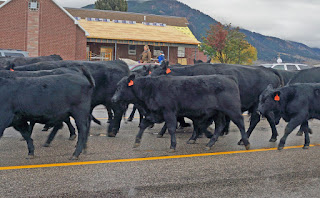After we had talked of hiking and biking, a young Hispanic man told
me that I should ride a trail known to locals as Putt-Putt. It’s great biking, he said—easy. But his description of how to find it was
less than great.
There is no word in English for “going somewhere without
caring whether or not you get there.” A vacilador does this in Spanish. There are many hispanic people in Jackson,
Wyoming. Most of them serve the tourist
industry which is about the only industry here.
Their relaxed and friendly nature makes things work around here. Why would we want them to leave? They have worthy goals, whereas mine for
today is merely to see where the bicycle takes me.
Unlike workers who serve breakfast and clean motel rooms, I’m
a vacilador, set out on a bicycle not
caring if I find Putt-Putt or not.
I rode just a mile in early morning to the Virginian Café and
stopped cold. I sat sipping coffee in
its warmth until nine in the morning, when the thermometer outside the window
finally rose above freezing. Then I donned
my winter coat and thick gloves, went outside and thought about sadly scorched
souls in sunny summerland of the magic kingdom.
I rode east until I was out of Jackson and found a little sign
pointing up a dirt road, saying “Trailhead.”
Another sign read “Putt-Putt.” I
had found it, but it was not an easy trail to ride. I soon gave up trying, and walked the bike
instead. No, I did not fall off, the
bike is merely resting there on its side.

 Off to the right I saw a small cabin, its door swinging
open. I called as I approached it curiously,
thinking a young Hispanic man might answer, but no response. Inside was a shamble of things. I shrugged unknowing, then returned to the
trail and resumed pushing the bike up the hill.
Off to the right I saw a small cabin, its door swinging
open. I called as I approached it curiously,
thinking a young Hispanic man might answer, but no response. Inside was a shamble of things. I shrugged unknowing, then returned to the
trail and resumed pushing the bike up the hill.
The day was warming fast, and I shed some layers of
clothing. Rising above Jackson I looked
down on the town and wondered what the young man had been thinking when he told
me I would like this bike trail and that it was easy.


The trail led into aspen woods and, still pushing the bike, I
felt better about being a vacilador. It seemed that good things lie outside of
cities, and I could learn something in this good place.
How could anyone think that riding a bicycle on a trail like
this is more fun than walking?
A pair of hikers came along and thought it strange I’d be here
with a bike. “Do you actually ride it,”
they said, and offered to take my picture if I would.
 I came into some deep woods, where a river runs through
it. Whose woods these are I do not know,
but they were very pleasant and inspired thoughts of an earth that was very old
when I came into it.
I came into some deep woods, where a river runs through
it. Whose woods these are I do not know,
but they were very pleasant and inspired thoughts of an earth that was very old
when I came into it.

On
the Putt Putt path, she plants her bike
in the grasses and sizes up the deepening trail.
The roots of an old pine grasp the ground
as if to say “this is where I began,”
“this is where I’ll end.”
Lois P Jones
Hunting season begins soon and I’m advised to wear bright
orange so not to look like an elk or a deer.
It’s a hunt prescribed to prevent overcrowding of these native
animals. Meanwhile it seems to me there
are too many people here in summer. Now
in fall, hunt completed, there are not too many.

At dusk deer meet
Lee Collins
in deep pines, content
to mingle idly, ruminate grass,
but delicately intent
mindful of someone shooting
far ahead,
they pause to look, mouths agape
tasting that cold bitter air.
I finally came to a smooth dirt road on which I rode easily,
and came pleasantly back into Jackson. It
could have turned out much differently.

 I set out on a Forest Service road called Skyline Drive after
a day of rain, hoping its seventy miles of dirt road would not bring my jeep to
a creative stop. I started up the first
ten miles, gaining several thousand feet of elevation, knowing I could come
back down. The road turned from gravel to mud, and then it turned
downhill. I walked ahead to make a decision. It was not worth the risk. I turned back.
I set out on a Forest Service road called Skyline Drive after
a day of rain, hoping its seventy miles of dirt road would not bring my jeep to
a creative stop. I started up the first
ten miles, gaining several thousand feet of elevation, knowing I could come
back down. The road turned from gravel to mud, and then it turned
downhill. I walked ahead to make a decision. It was not worth the risk. I turned back. 





















































